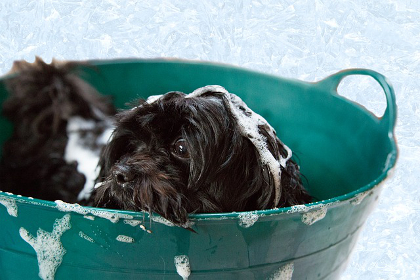
Chemical Contents in Your Soap and Shampoo
You may be happy to know that the U.S. Food and Drug Administration (FDA) prohibits the use of mercury, chloroform and nine other substances in your shampoo, soap and other personal care products.
That is, until you learn that the European Union prohibits the use of more than 1,300 substances in their personal care products.
The FDA's paltry restriction of just 11 substances is even more ridiculous considering there are nearly 13,000 chemicals used in cosmetics, and only about 10 percent have been evaluated for safety.
Although the FDA has the authority to regulate harmful ingredients in cosmetics and personal care products, it typically doesn't, preferring instead to rely on the products' manufacturers to regulate themselves.
If customers claim that a product has caused them harm, however, the companies are not required to report such claims to the FDA. And in the event that a product is deemed to be harmful, the FDA can't even order a recall.1
April 20, 2016 | Source: Mercola.com | by Dr. Joseph Mercola
You may be happy to know that the U.S. Food and Drug Administration (FDA) prohibits the use of mercury, chloroform and nine other substances in your shampoo, soap and other personal care products.
That is, until you learn that the European Union prohibits the use of more than 1,300 substances in their personal care products.
The FDA’s paltry restriction of just 11 substances is even more ridiculous considering there are nearly 13,000 chemicals used in cosmetics, and only about 10 percent have been evaluated for safety.
Although the FDA has the authority to regulate harmful ingredients in cosmetics and personal care products, it typically doesn’t, preferring instead to rely on the products’ manufacturers to regulate themselves.
If customers claim that a product has caused them harm, however, the companies are not required to report such claims to the FDA. And in the event that a product is deemed to be harmful, the FDA can’t even order a recall.1
Do You Know What’s in Your Shampoo?
It’s a simple enough question, but chances are you have no idea what’s lurking in your shampoo. Even if you read the label, you probably won’t recognize most of the ingredients. The fact is if you use common commercial shampoos, you’re lathering up your scalp with chemicals with every wash.
Several years back many people were shocked to learn that even Johnson & Johnson’s baby shampoo contained toxic chemicals like formaldehyde and 1,4-dioxane.
In response to consumer demand, in 2012 Johnson & Johnson agreed to remove some of the toxic chemicals from their products (and reportedly took formaldehyde and 1,4-dioxane out of their personal care products as of 2015).2 However, many questionable chemicals still exist in popular shampoos.
Shampoo commonly contains endocrine disruptors, for instance, which are chemicals known to interfere with development and reproduction, and they may cause serious neurological and immune system effects. What else might be in your shampoo?
• Sodium lauryl sulfate, a surfactant, detergent and emulsifier used in thousands of cosmetic products, as well as in industrial cleaners.
It’s present in nearly all shampoos, scalp treatments, hair color and bleaching agents, toothpastes, body washes and cleansers, make-up foundations, liquid hand soaps, laundry detergents, and bath oils/bath salts.
The real problem with SLES/SLS is that the manufacturing process (ethoxylation) results in SLES/SLS being contaminated with 1,4 dioxane, a carcinogenic byproduct.
• Phthalates are plasticizing ingredients that have been linked to birth defects in the reproductive system of boys and lower sperm-motility in adult men, among other problems. Be aware that phthalates are often hidden on shampoo labels under the generic term “fragrance.”
• Methylisothiazolinone (MIT), a chemical used in shampoo to prevent bacteria from developing, which may have detrimental effects on your nervous system.
• Parabens, chemicals found in shampoo, deodorants and other cosmetics, have been shown to mimic the action of the female hormone estrogen, which can drive the growth of human breast tumors.
A study published in 2012 suggested that parabens from antiperspirants and other cosmetics indeed appear to increase your risk of breast cancer.3
The research looked at where breast tumors were appearing and determined that higher concentrations of parabens were found in the upper quadrants of the breast and axillary area, where antiperspirants are usually applied.
Cancer-Causing, Hormone-Disrupting Chemicals and Heavy Metals Are Common
Unfortunately, you cannot assume that your personal care products are safe, and it’s not only shampoo and soap (often loaded with toxic antibacterial triclosan) that’s the problem.
One of the biggest offenders is hair straightener, some brands of which may contain up to 10 percent pure, cancer-causing formaldehyde. Not only does this pose a risk to the customers using the product but also the stylists who apply it.
Further, when the Environmental Working Group (EWG) tested teens to find out which chemicals in personal care products were found in their bodies, 16 different hormone-altering chemicals, including parabens and phthalates, were detected.4
Another EWG study found that 37 nail polishes from 22 companies contained dibutyl phthalate (DBP), which is known to cause lifelong reproductive impairments in male rats, and has been shown to damage the testes, prostate gland, epididymus, penis, and seminal vesicles in animals.
It’s used in nail polish because it increases flexibility and shine; research by the U.S. Centers for Disease Control and Prevention (CDC) revealed that all 289 people they tested had DBP in their bodies.5
Worse still, this chemical, which is linked to birth defects in animals, was found at the highest levels in women of childbearing age.
Environmental Defense also tested 49 different makeup items, including foundations, concealers, powders, blushes, mascaras, eye liners, eye shadows, lipsticks and lip glosses.6 Their testing revealed serious heavy metal contamination in virtually all of the products:
- 96 percent contained lead
- 90 percent contained beryllium
- 61 percent contained thallium
- 51 percent contained cadmium
- 20 percent contained arsenic
